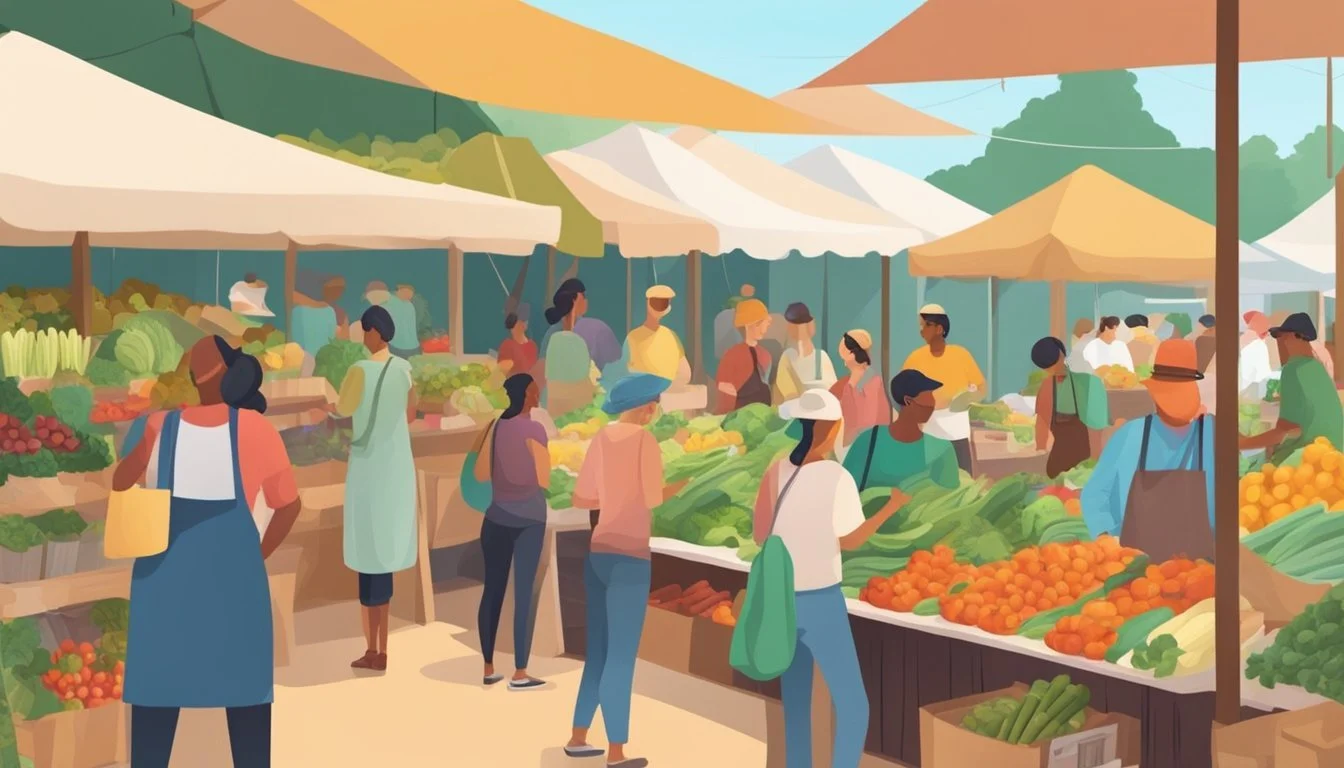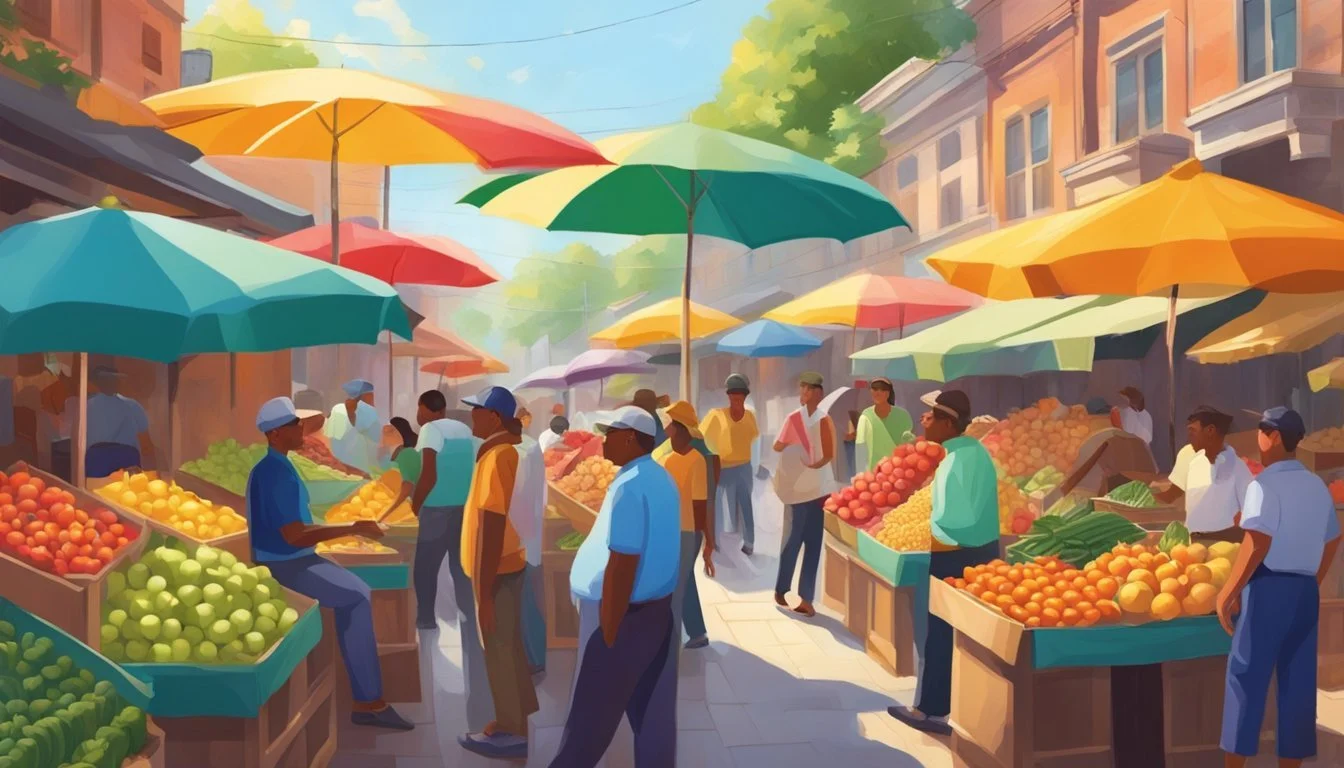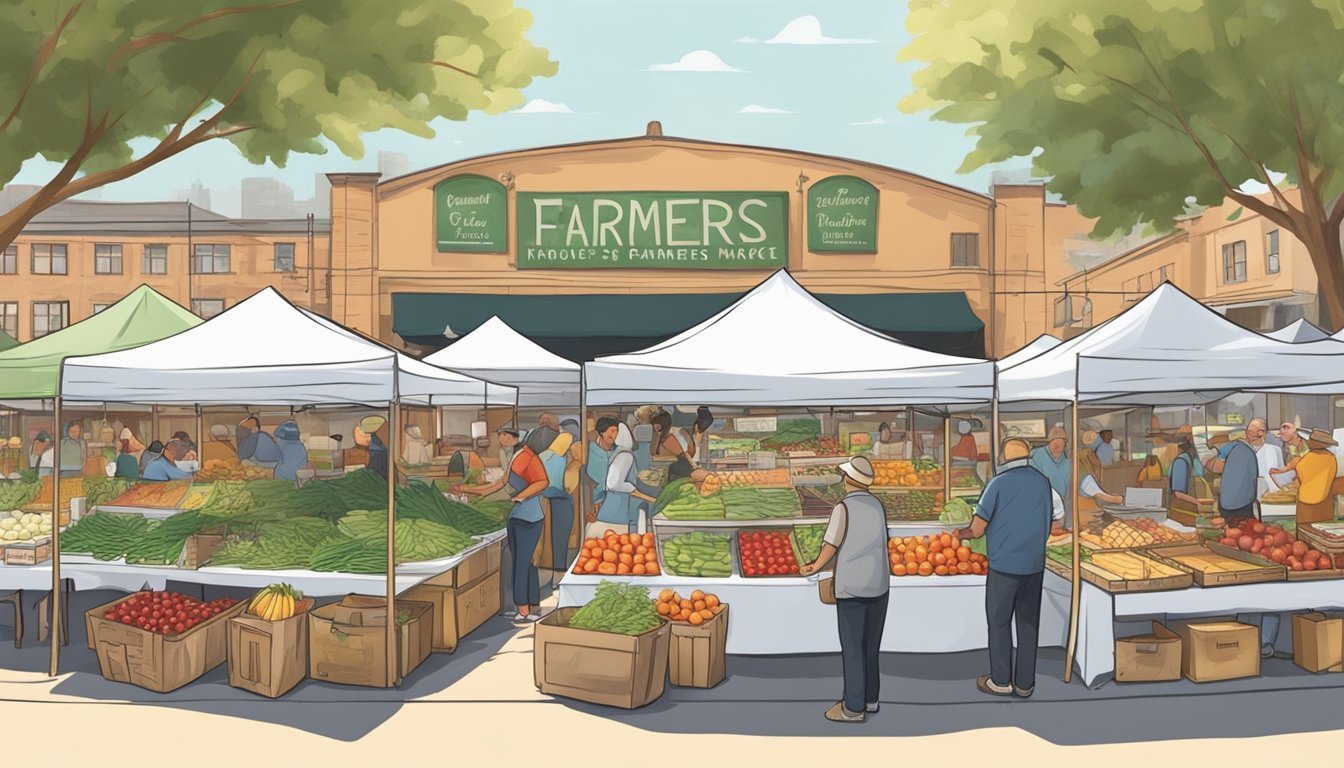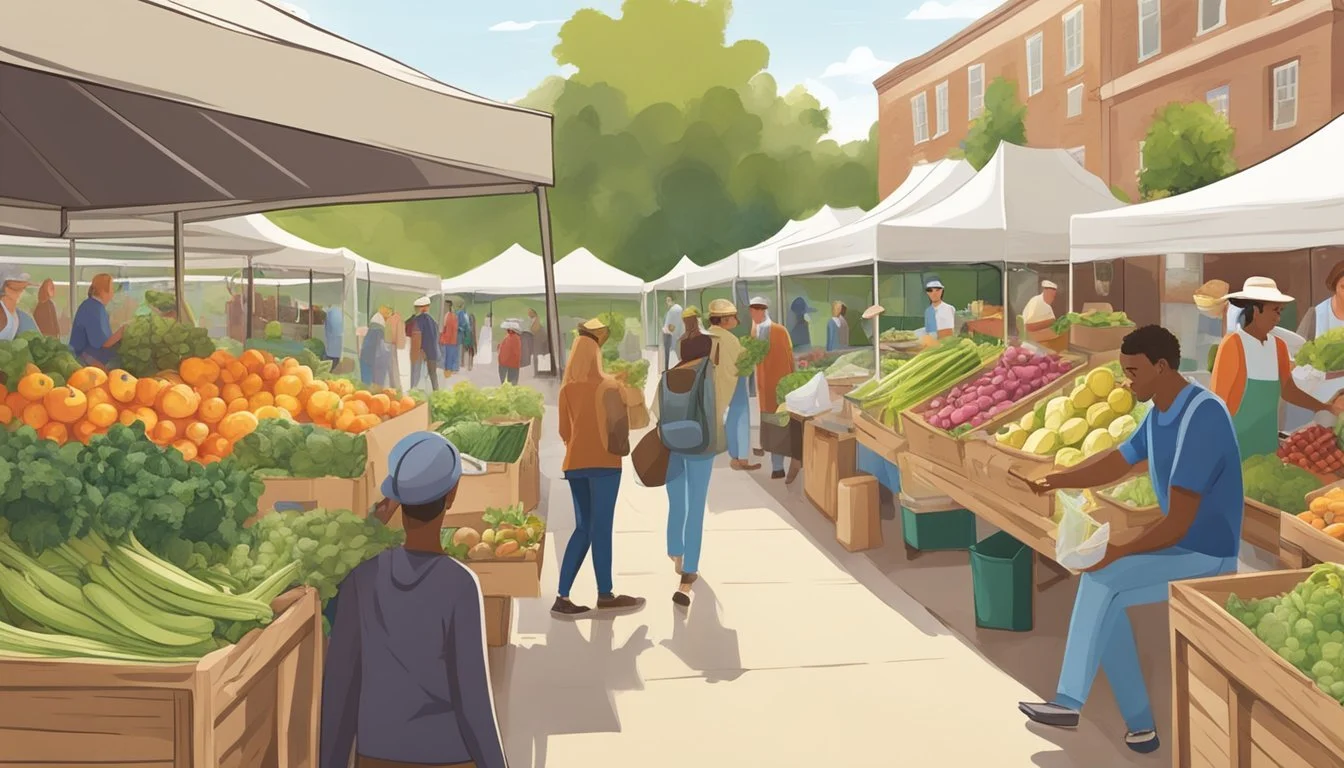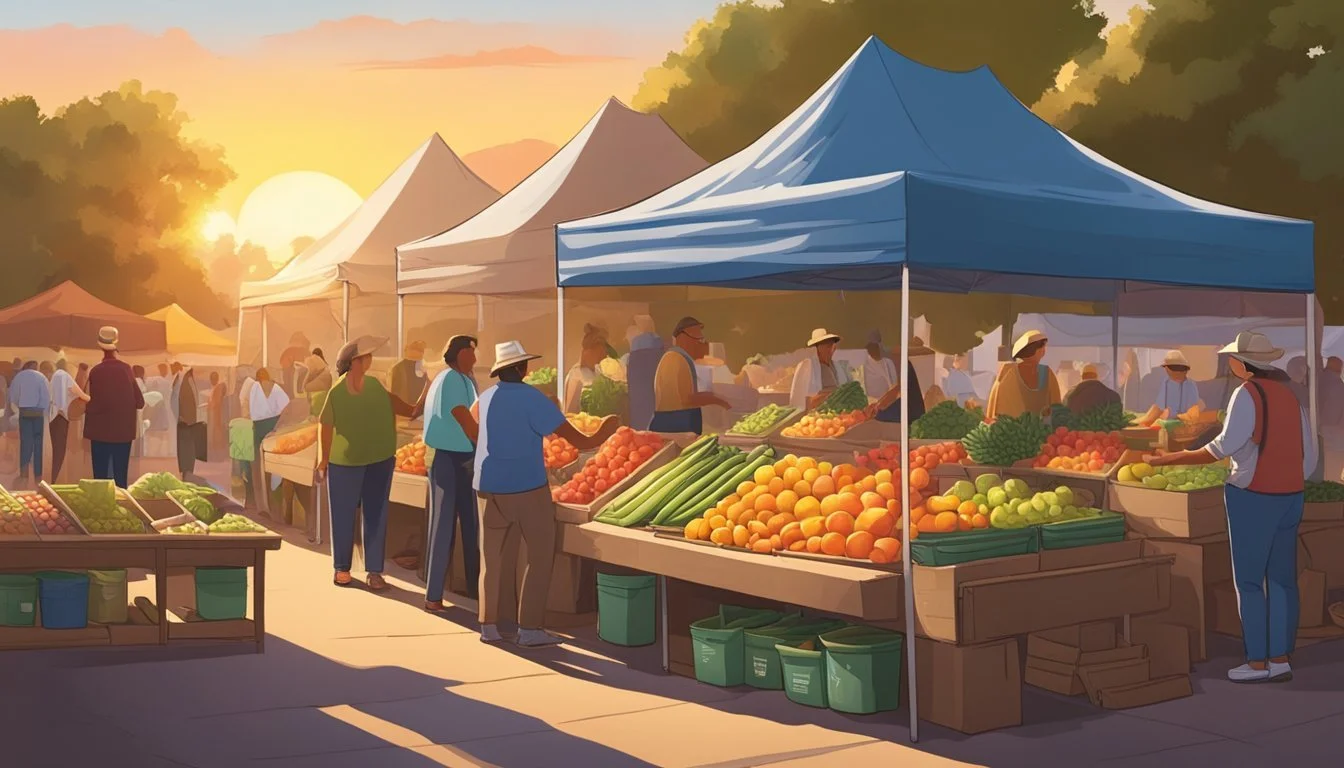Behind the Booth
Unveiling the Lives of Farmers' Market Vendors
Farmers' markets are a treasure trove of stories, each booth holding a unique narrative as diverse as the products on display. Here, vendors are not just sellers but storytellers, offering a glimpse into the care and craft behind their offerings. Shopping at a farmers' market provides an experience that goes beyond the transactional; it's an interaction with the passion and hard work of individuals who are often the producers, artists, and innovators of the items they sell. From the amethyst stones of a crystal vendor to the rich hues of local honey, each booth presents an opportunity for customers to learn about the origins of their purchases straight from the source.
Engaging with market vendors at a farmers' market brings a layer of connection to the shopping experience. It's a space where consumers can ask questions, hear anecdotes, and gain insights into the products they take home. Vendors like the proud owner of a honey and candle booth invest not only in the quality of their products but also in the story and brand they represent, vying to make their message resonate among a sea of other options. Through direct dialogue, a simple purchase becomes an educational moment, imbuing the items with a personal touch that is often absent from conventional retail settings.
As patrons wander through the stalls, each interaction reveals the complexities of small-scale commerce. For some, such as the vendors at Overland Park’s farmers' market or the diverse community at the Vancouver Farmers Market, there's a journey of adaptation and hard-won success. These markets are more than just points of sale; they are communal hubs where the vendor's dreams and customer curiosity meet. Whether it's a family-run livestock farm or a booth bursting with garden-fresh produce, the vendors' dedication forms the backbone of the farmers' market ethos, offering a shopping experience enriched with authenticity and warmth.
The Essence of Farmers’ Markets
Farmers' markets are more than just outdoor venues for shopping; they are heartbeats of local communities. These markets serve as a stage for family-owned enterprises to showcase their dedication to cultivating and providing fresh produce. Customers frequent these markets, not just for groceries but for an experience that weaves health, taste, and a sense of community into a single visit.
The produce found here often boasts an organic status, free from the extensive use of synthetic pesticides and fertilizers, thereby promoting health. This aspect appeals to consumers' growing preference for natural food options. Local produce is a hallmark of these markets, reflecting seasonality and regional agriculture. Consumers gravitate towards these offerings for their superior freshness, which stands in contrast to the longer supply chains of supermarkets.
Additionally, farmers’ markets foster a sense of community through direct, interpersonal transactions. They become a weekly ritual where smiles are exchanged, and stories are shared, nurturing bonds between grower and buyer. Here, one can often find advice on cooking and storage directly from the source.
Farmers' markets are integral in sustaining the local economy as well. The support funneled into these markets directly uplifts the local agricultural sector, ensuring these businesses can continue to thrive.
Advantages Description Community Focused Cultivating relationships beyond commerce. Health Conscious Promoting the sale of fresh, often organic produce. Economically Empowering Encouraging financial growth within the local community.
In essence, these markets embody resilience, sustainability, and the celebration of homegrown goods, nurturing not just the body but the communal spirit.
Meet the Vendors
Farmers' markets are vibrant hubs where vendors' personal stories interweave with the exceptional produce they sell. These individuals bring a unique blend of passion and expertise to their booths while fostering a friendly marketplace atmosphere.
Personal Journeys
Each vendor's path to the farmers' market is as distinct as their produce. At the Town Center's Wednesday and Friday markets, for instance, a booth appropriately named Amethyst from Uruguay showcases the result of their journey, offering amethyst stones alongside similar crystals. They stand as a testament to the diverse backgrounds that enrich the market's tapestry.
Passion for Produce
Vendors' commitment goes beyond mere selling — it's an embodiment of their dedication to quality and a sustainable lifestyle. For some, like Windy River Livestock, the dream has always been farming, and the market offers a platform to share the fruits of their labor. The assortment of goods ranges from fresh vegetables, herbs, to homemade treats, all brought to the market with a passion for sharing the best of what they harvest.
Selling Points
A vendor booth is more than a selling space; it represents opportunities and challenges. Vendors at the Vancouver Farmers Market, part of Southwest Washington's leading visitor attraction, cater to a vast audience with their products. They offer locally-sourced produce and artisanal goods, ensuring that customers have access to both quality and variety. At markets such as the Overland Park's, which was voted best in the U.S., the focus on providing a friendly and personal customer experience is what sets them apart, demonstrating the selling points are as much about the interaction as the products themselves.
Booth Setup and Display
Creating an inviting and efficient booth setup not only draws customers in but also enhances the shopping experience. The display should be both visually appealing and functionally organized to showcase products effectively.
Design and Aesthetics
A farmer's market booth thrives on its visual appeal. Vendors should infuse their booth design with vibrant colors and textures to attract customers. For example, using tablecloths that complement the natural hues of the produce can create an eye-catching tableau. Adding height to displays with stacked crates or shelves allows for a dynamic presentation of goods, making them more visible and enticing. A theme may also be incorporated, such as a "tropical oasis," with the use of palm leaves under exotic fruits placed in brightly colored baskets.
Use of color: Bright, natural colors that enhance the product's look.
Adding dimension: Tiered displays encourage eye movement and interest.
Thematic elements: Consistent decor elements that relate to the products sold.
Practical Tips for Organization
The organization is key for smooth operation and customer flow. A well-organized booth with clear signage leads to a better shopping experience. Tables should be arranged so that products are within easy reach of both the vendor and the customer, and displays should be restocked regularly to maintain a look of abundance. It is also important to ensure the tent is securely anchored, providing shelter from sun or rain without obstructing the view of the products. Thoughtful placement of baskets can facilitate the grouping of similar items, making it easier for customers to find what they are looking for.
Clear signage: Legible and descriptive signs that guide customers.
Accessible layout: Adequate space for customers to navigate and vendors to operate.
Secure and safe: A tent and display setup that withstands weather while protecting the goods.
Products on Offer
Farmers' markets are treasure troves of produce, each vendor's booth serving as a window into the region's agricultural and artisanal richness.
Freshness and Variety
Vegetables and fruits spill from baskets in a kaleidoscope of colors at the farmers' market, showcasing the peak of seasonal freshness. Vendors often rise before dawn to harvest their crops, ensuring that patrons take home the crispest greens and the juiciest fruits.
Homemade Goodies
The aroma of baked goods often lures visitors deeper into the market. Artisan bakers offer an assortment of breads, pastries, and other oven-baked delights. The selection extends to cheese, where the market's cheesemakers provide a diverse array of locally-crafted cheeses, from bold blues to creamy bries.
Unique Finds
Beyond the staples, farmers' markets are known for unique finds. One may discover hard-to-find cuts of meat or encounter products like specialty maple syrups straight from the family-owned Schoolyard Sugarbush, enhancing the culinary experience beyond the ordinary.
Understanding the Customers
Farmers' market vendors thrive when they tap into the essence of customer engagement. A vendor's success hinges not just on the quality of their products but also on how well they understand and connect with their customers.
Building Relationships
Vendors know that establishing rapport with customers is paramount. They engage in direct conversation, listening to feedback and sharing stories, which often turns a casual buyer into a loyal customer. Regular interactions create a bond of trust and familiarity, encouraging repeated business.
Key strategies include:
Greeting customers by name
Remembering previous purchases
Offering personalized recommendations
Sharing product origins and usage tips
Engaging with the Community
Vendors recognize that farmers' markets are more than just places to shop; they're communal spaces where people gather and form connections. By actively participating in the life of the community, vendors become fixtures that people look forward to visiting.
Community engagement looks like:
Hosting activities or workshops related to their products
Collaborating with other vendors for cross-promotions
Supporting local charities or events
Encouraging a market-wide atmosphere that enhances the shopping experience
Pricing Strategies
When visiting a farmers' market, customers expect to find fresh, quality produce and goods, often with the bonus of supporting local agriculture. But how vendors set their prices can be the difference between profit and loss. They must balance a competitive edge with the likelihood of providing good value and maintaining transparency to their customer base.
Competitive Pricing
Vendors at farmers' markets often survey other stalls and local grocery stores to ensure their prices are competitive. Competitive pricing is critical; it helps vendors stay attractive to buyers while ensuring they do not undervalue their products. For instance, a vendor selling organic, no-till salad greens may price their goods higher than conventional produce but should keep prices in line with organic equivalents in the area to strike a balance between fairness and profitability.
Product Type Farmers' Market Price Equivalent Organic Store Price Organic Salad Greens $5 per bag $6 per bag Handmade Jewelry $20 per item $25 per item
Value Proposition
The idea of value proposition extends beyond mere numbers; it weaves in the stories behind the products, the artisanal or sustainable methods used, and the personal connection a seller can establish with the buyer. For instance, a vendor specializing in handmade jewelry may incorporate costs like raw materials, time, and booth space into their pricing strategy while also highlighting the unique design and craft of each piece to justify the price and elucidate the deal a customer gets.
Farmers build their value proposition by focusing on transparency about production costs, which fosters trust and communicates good value. Keeping meticulous records of expenses and revenues allows them to justify their prices to customers, demonstrating the integrity behind their pricing strategies.
Transparency about costs plays a significant role in effective pricing. If customers understand the farmers' costs, they're often more willing to pay for the perceived added value of local, sustainably produced goods. Without transparency, vendors may struggle to communicate the quality and effort that justifies their prices.
Regulations and Logistics
Farmers' market vendors are subject to a complex set of regulations and logistical considerations that dictate their operations. The importance of understanding these rules cannot be overstated, as they ensure a smoothly running market that complies with local, state, and federal guidelines.
Permits and Compliance
Vendors must secure various permits to operate within farmers markets. These often include:
Business Licenses: Depending on the location, vendors may require a business license to sell their goods.
Health Permits: For food vendors, health department permits ensure the safety and quality of consumables.
Operating outside the mandated permits and compliance requirements can result in fines or revocation of the right to sell at the market.
Market Operations
The operational rules for vendors at farmers markets encompass:
Hours of Operation: Markets typically have set hours during which vendors are expected to be open for business.
Booth Location: Assignments for booth spaces are often predetermined and can be influenced by the type of products sold.
Rules and Procedures: Vendors must adhere to the market's rules, which could affect the future of their operations at the market.
Understanding these rules is crucial for successful participation in farmers markets and for planning future business strategies.
Additional Offerings
Farmers' market vendors frequently augment their booths with an array of seasonal specials and handcrafted non-food items. These additions not only provide variety but also cater to the evolving interests and needs of the market's clientele.
Seasonal Specials
Vendors often feature seasonal specials to highlight the best of what the season has to offer, enticing customers with fresh, time-specific produce or themed products. For example:
Spring: Vendors might offer a colorful variety of flowers or tender microgreens, which are popular for their nutrition and flavor.
Summer: The stall might burst with exclusive hot sauce varieties made from peppers harvested at their peak.
Fall: Speciality items like pumpkin-spiced honey can make an appearance.
Winter: During the colder months, holiday-themed products such as wreaths or poinsettias might be featured.
Crafts and Non-food Items
Alongside edible goods, artisans enhance their booths with crafts and non-food items, adding a unique touch to their space. Some common offerings might include:
Honey: Local, raw honey, often available in decorative jars, appealing to those interested in natural sweeteners.
Soap: Handcrafted soaps using farm-sourced ingredients, popular for their organic appeal and unique scents.
Candles: Similar to soaps, these can be made with natural components like beeswax, and might come in an assortment of fragrances.
Decor: Homemade decor items can also be found, which may include flower arrangements or hand-painted signs.
Marketing and Promotion
Successful farmers' market vendors understand that effective marketing and promotion tactics are crucial for attracting customers and generating sales. They often employ a variety of strategies, from networking with local businesses to leveraging the power of social media for outreach.
Networking with Businesses
Farmers' market vendors can considerably expand their customer base by networking with local businesses, such as restaurants and grocery stores. Building relationships with these entities often leads to fruitful collaborations. Vendors might supply fresh produce to restaurants or set up promotional displays in grocery stores. Sharing business cards at the market can also facilitate easy communication and future engagement with these local business partners.
Social Media Outreach
Social media platforms are powerful tools for farmers' market vendors to promote their booths and products. Effective social media outreach involves:
Creating Engaging Content: Vendors can post photos and videos showcasing their products, sharing behind-the-scenes insights, or announcing new offerings to engage their audience.
Hashtag Use: Utilizing relevant hashtags can increase the visibility of posts to a wider audience interested in local and fresh foods.
Scheduled Posts: Regular posting maintains visibility and keeps consumers informed about market days, seasonal produce, or special promotions.
A strong social media presence can not only attract more customers to the farmers' market but also educate the public about the benefits of supporting local agriculture.
Transactions and Payments
Farmers' market vendors manage a variety of transactions, ensuring a smooth exchange of goods for payments. They typically handle both cash and electronic payments, each requiring different approaches.
Handling Cash
Vendors often use a cash box as a secure and organized way to manage cash transactions. They keep a variety of denominations for change and may use a locking system to prevent theft. Some vendors participate in programs like the Supplemental Nutrition Assistance Program (SNAP), where they accept vouchers or tokens in place of cash, providing an essential service to the community.
Securing the cash box: A lockable box with a slot or drawer is common.
Making change: Keeping plenty of small bills and coins is key.
Accepting SNAP: Special procedures are followed to accept and process SNAP benefits.
Electronic Payments
The evolution of payment technology allows vendors to accept payments beyond cash. Using devices like tablets or smartphones, they can process credit cards, NFC payments such as Apple Pay, or manually enter card details. This convenience often leads to increased sales and customer satisfaction.
Payment platforms: Systems like Square support various payment methods.
Security features: Transactions are encrypted for customer safety.
Receipt options: Digital receipts can be sent via email or text, which is an eco-friendly solution.
Sustainability Practices
Sustainability is at the heart of farmers' market operations. Vendors often adopt a range of practices to ensure that their products are not only high-quality but also environmentally friendly. The cultivation of organic produce is a significant aspect of sustainable farming. These vendors typically abstain from using synthetic pesticides and fertilizers, which are harmful to the environment. Instead, they employ natural methods to enrich the soil and control pests.
A notable sustainable practice involves the reduction of food miles. By selling locally, these markets minimize the carbon footprint associated with long-haul transportation. Here is a breakdown of common sustainable practices:
Local Sourcing: Reduces transportation emissions.
Organic Methods: Maintains soil health and ecosystem balance.
Composting: Converts waste into soil nutrients.
The vendors at farmers' markets also tend to have a close relationship with their produce, which translates into a commitment to offer high-quality food items. They often use heirloom varieties and prioritize biodiversity, which can lead to better soil health and less dependence on artificial interventions.
Furthermore, some markets provide education on sustainable practices, helping consumers make informed decisions that support the environment. This educational aspect can weave sustainability into the fabric of the community, creating a cycle of awareness and action.
In conclusion, farmers' markets act not just as a point of sale for fresh products but also as a hub for sustainable living, fostering a direct connection between ethical consumption and community well-being.
Future of Farmers’ Markets
Farmers' markets are adapting to changing trends with innovation and technology. As consumer interest in local and sustainable food rises, farmers' markets are poised for growth. They serve as vital sales outlets for family-owned, small-scale farms.
Technological Integration
Vendors are beginning to embrace digital tools to reach customers. Online marketplaces, pre-ordering apps, and electronic payments are becoming common. These innovations can streamline the shopping experience and potentially expand the customer base.
Community Role
Farmers' markets have become community hubs. Markets often host local musicians, offer cooking demos, and provide family-friendly activities. This community support functions to foster a loyal customer base and encourage repeat visitors.
Sustainability
Sustainability efforts are at the forefront of market operations. Many markets now highlight organic and eco-friendly practices, reinforcing the connection between the health of the environment and high-quality produce.
Vendor Development
Small-scale vendors receive resources to grow and sustain their businesses.
Educational programs are offered on best practices and emerging market trends.
Consumer Demand
An emphasis is placed on locally-sourced products, appealing to consumers interested in supporting local economies.
The demand for fresh, artisanal, and niche products continues to drive a diverse range of offerings at the market.
Farmers' markets appear set to continue thriving by sticking to their roots in community connection while embracing modern changes.
Conclusion
Farmers' markets serve as vibrant hubs for agricultural commerce, while each vendor brings a narrative as unique and diverse as their offerings. From the individual selling amethyst stones from Uruguay to the beekeeper whose slogan "Bee Fueled, Bee Inspired" captivates crowds, these markets are more than mere trading spaces—they are storytelling platforms.
Key Takeaways from Vendors' Stories:
Personal Touch: Vendors impart a personal connection to their goods, often a reflection of their hard work and dedication.
Unique Identity: Stalls stand out through distinctive branding and storytelling.
Price Perspectives: The pricing at markets may vary, underscoring a valuation of quality, local production, and the effort behind each item.
At their core, farmers' markets foster community engagement and provide insight into the agrarian lifestyle. Vendors not only share their artisanal products with customers but also their journeys, challenges, and successes. Each market visit thus becomes an opportunity to engage with local entrepreneurs and to appreciate the intricate tapestry of stories that knit together the tapestry of local commerce.
In summary, markets captivate and sustain interest not just through quality goods, but through the rich, interwoven stories of the people behind the booths. A visit to the farmers' market is a celebration of the community and an endorsement of local enterprise, where every purchase is a narrative discovered and a small triumph for local industry.

